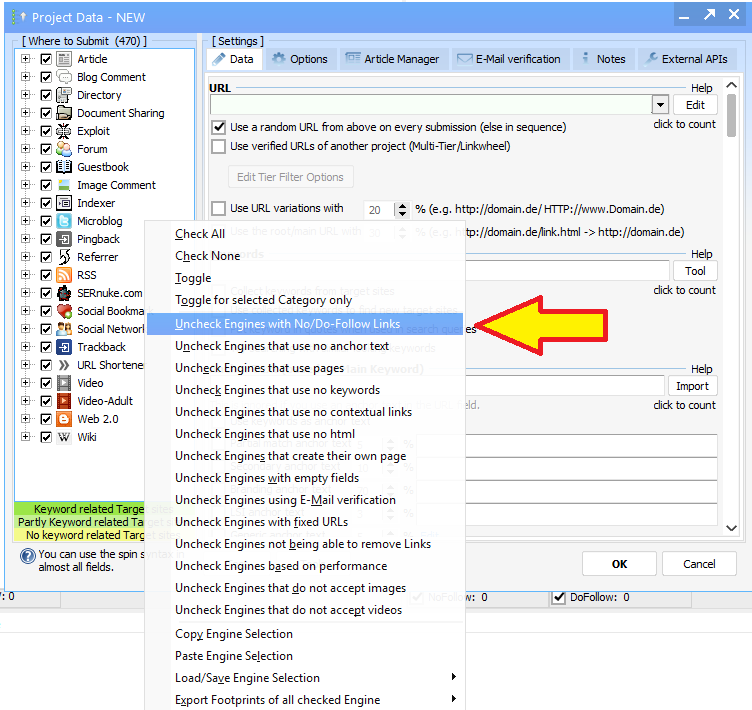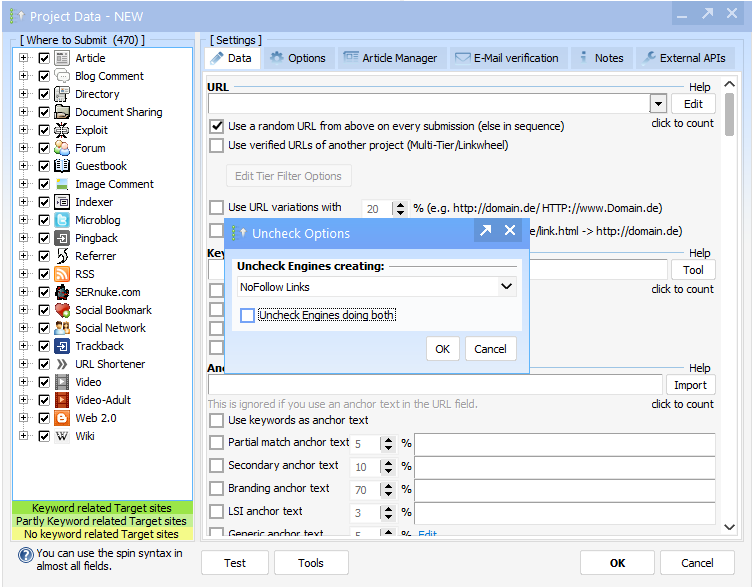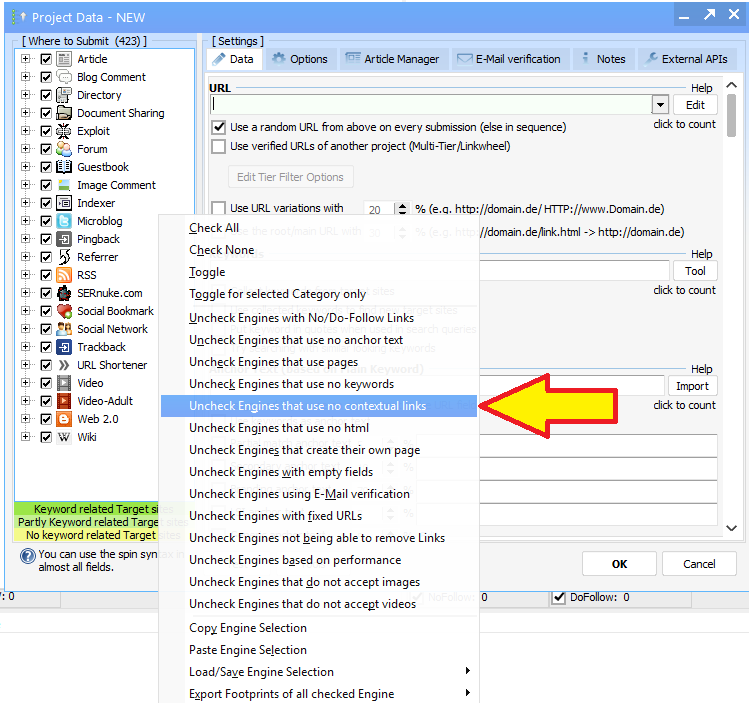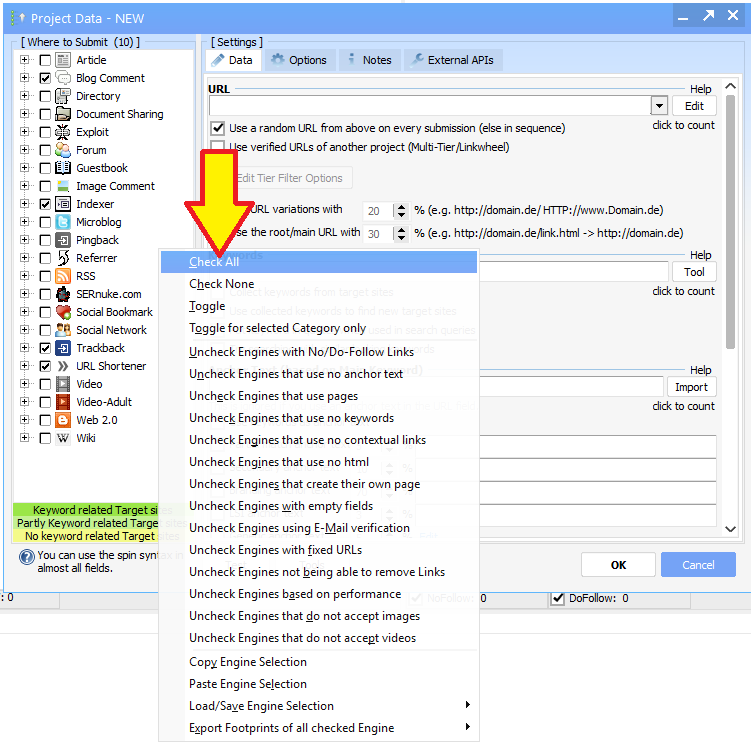I often get approached by GSA Search Engine Ranker users who tell me they want to build only contextual or do-follow links but are unsure which engines to select to create them.
This post is dedicated to showing you how to create contextual do-follow backlinks very easily with GSA Search Engine Ranker.
Before we get started with what to do in GSA Search Engine Ranker, I think it is essential that we first begin by looking at what exactly contextual and do-follow links are.
Contextual do-follow backlinks are links that appear within the content of a website page or blog post, pointing to another site (like yours), and they carry a bit of “authority juice” with them. Below is a simple breakdown:
What Are Contextual, Do-Follow Backlinks?
Contextual Backlinks
These are links that are naturally included in the body of an article or a blog post. They’re not in the footer or sidebar; they’re actually woven into the main content where they make sense for readers.
For example, if a blog post is discussing “digital marketing tips” and it links to a page with more in-depth information on that topic, that’s a contextual link.
Do-Follow Links:
These are links that allow search engines to follow and count them as “votes” towards the site they lead to.
When Google or other search engines see a do-follow link pointing to your website, they view it as a recommendation. It’s a way of saying, “This is a trustworthy and relevant source,” which helps boost the linked site’s ranking in search results.
Why Contextual Do-Follow Backlinks Are Important
Higher SEO Value: Google sees these links as more relevant and trustworthy because they’re surrounded by related content. For instance, a link about SEO strategies within an article on digital marketing is seen as more valuable than a random link on a page about cooking recipes.
Improved Rankings: Since do-follow backlinks signal to search engines that your site is credible, they can boost your ranking on search results pages. The higher the ranking, the more traffic and visibility your site can gain.
Natural Traffic: Contextual links within engaging articles often attract clicks from interested readers, leading to organic traffic.
Examples of Contextual Backlinks
Contextual backlinks carry extra power because they're naturally woven into relevant content. These links sit among related text, which makes them more valuable to readers and search engines alike. You'll find examples below showing how contextual backlinks can boost SEO authority and drive targeted traffic. Below are 2 examples of contextual backlinks.
Contaxtual Example 1:
Imagine a travel blog post titled “Top Digital Marketing Strategies for 2024.” In one paragraph, it mentions, “One of the best tools for managing online marketing is GSA Search Engine Ranker.” If GSA Search Engine Ranker is linked to your product page, it’s a contextual do-follow link.
Contextual Example 2:
A fitness blog posts an article on “Effective Ways to Handle Sleep Disorders.” Within the content, it links the phrase “high-quality CBD products” to a website selling CBD for sleep improvement. This is relevant, so Google values it as a quality contextual link.
Contextual do-follow backlinks work like referrals from a trusted friend. When other reputable sites link to your content, you'll see higher rankings on Google and other search engines, which improves your online visibility.
Understanding Do-Follow and No-Follow Links
Links in SEO fall into two categories: do-follow or no-follow, depending on whether they'll pass authority (or “link juice”) to the linked website. The HTML code below reflects this distinction.
Do-Follow Links
Most links are do-follow by default, meaning search engines like Google will follow them and pass authority from one page to another. Since do-follow links can boost the linked page's SEO ranking, they're highly valuable.
Example Code for a Do-Follow Link
<a href=”https://yourwebsite.com“>Check out our SEO tools</a>
In this example, there’s no extra attribute added to the link, making it a do-follow link by default.
No-Follow Links
A no-follow link tells search engines they shouldn't follow or transfer authority to a linked page. Website owners often add this attribute to links in comment sections, sponsored content, or ads to avoid passing “link juice” unintentionally.
Example Code for a No-Follow Link:
<a href=”https://yourwebsite.com” rel=”nofollow“>Check out our SEO tools</a>
Adding rel="nofollow" to the link tells search engines to ignore this link when calculating authority, so it won’t impact the linked page’s SEO.
Understanding different link types lets website owners control their site's link profile by managing which links pass SEO value and which don't.
How To Create a Contextual, Do Follow project in GSA Search Engine Ranker
Building quality contextual do-follow backlinks is a key component of any effective SEO strategy, and GSA Search Engine Ranker lets you automate this process efficiently. When you carefully select platforms and filter for do-follow, contextual links, you'll build strong, SEO-friendly backlinks that'll help elevate your site's authority and ranking.
If you combine these GSA Search Engine Ranker projects with alternative strategies like guest posting and data-driven content, you'll further diversify your backlink profile and strengthen your online presence.
Selecting the GSA Search Engine ranker platfoms
Start a GSA SER project as you would normally do, but this time, right-click anywhere in the platform area and select the option “CHECK ALL,” as shown in the screenshot below.
Remove the sites to does not offer do follow links
Now that we have checked all the platforms available in GSA Search Engine Ranker, we will eliminate the platforms we do not want, starting with removing all platforms that do not offer do-follow links. Once again, right-click anywhere in the platform area and select the option: “Uncheck Engines with No/Do Follow.“

In the next window, select “Uncheck Engines Creating” and “NoFollow Links” below that.

What this will do is it will automatically uncheck all of the engines \ platforms that create no-follow links.
You will see a check box with an option to “Uncheck Engines doing both.” Some sites offer both do-follow and no-follow links. If you want to be very strict, you can check both, so you will ONLY get to follow links.
Ok, now we have completed the first part, which was to disable all the platforms or engines as they are known. In the next section, we will move all the platforms \ engines that do not create contextual links
Remove the sites to does not offer contextual links
Now that we have started our project, we checked all links and eliminated all the platforms \ engines that build no-follow links; the next thing is to remove those platforms \ engines that do not build contextual links. Follow the easy steps below.
Again, right-click anywhere in the section where the platforms are, and this time select “Uncheck Engines That use no Contectual links.” as shown below.

Well, that's it; we have completed our engine selection and will only build links on sites that offer do-follow contextual links.
You can further remove some engines you don't want, like all the adult engines, if you don't want those., and then complete the rest of your GSA Project as you would normally do.
Frequently Asked Questions about - Do Follow Contextual Backlinks
What are contextual do-follow backlinks?
Contextual do-follow backlinks are hyperlinks placed within relevant content that pass SEO value to the linked website. These links appear naturally within articles or blog posts where the surrounding text relates directly to the linked content.
How do contextual do-follow backlinks differ from other types of links?
Unlike standalone or footer links, contextual do-follow backlinks exist within related content, making them more valuable for search engines. They carry more authority because they provide users with relevant resources within the proper context.
What makes a backlink contextual?
A backlink becomes contextual when the surrounding text relates to both the anchor text and the linked page's content. The link should fit naturally within the paragraph and offer genuine value to readers.
Why do search engines value contextual do-follow links?
Search engines interpret contextual do-follow links as genuine recommendations because they appear within relevant content. This natural placement signals that the link serves a purpose beyond simple promotion.
How can websites earn contextual do-follow backlinks?
Websites can earn these links through content partnerships, guest posting, resource mentions, and creating valuable content others want to reference. The focus should be on providing genuine value to readers.
What role does anchor text play in contextual backlinks?
Anchor text helps search engines understand the topic of the linked content. Natural, relevant anchor text within contextual backlinks strengthens the connection between linking and linked pages.
Are all contextual backlinks do-follow by default?
No, websites can make contextual links, either do-follow or no-follow. Do-follow links pass SEO value, while no-follow links direct traffic but don't transfer authority.
What industries benefit most from contextual do-follow backlinks?
All industries can benefit from contextual do-follow backlinks, particularly those with information-rich content like technology, healthcare, education, and professional services.
How many contextual do-follow backlinks should a website aim for?
Quality matters more than quantity. Focus on obtaining relevant, authoritative contextual backlinks rather than pursuing a specific number. Each link should come from trusted sources within your industry.
Can contextual do-follow backlinks harm website rankings?
Poor-quality or irrelevant contextual backlinks can harm rankings. Links should come from reputable sources, appear in relevant content, and provide value to users.
Contextual Do Follow Backlink Statistics
- According to a study by Ahrefs, websites with do-follow backlinks receive 35% more organic traffic than those without.
- Research shows that 67% of SEO professionals consider contextual backlinks more valuable than directory listings or forum links.
- Data from Moz indicates that websites with natural contextual backlinks have 43% better domain authority scores.
- Studies demonstrate that contextual backlinks from relevant content generate 4x more click-through rates than random placements.
- Analysis reveals that 82% of high-ranking pages feature at least three contextual do-follow backlinks.
- SEO research indicates that contextual backlinks from sites within the same industry provide 2.5x more ranking power.
- Statistics show that 91% of pages without backlinks get no organic traffic from Google.
- Web pages containing contextual backlinks maintain their rankings 56% longer than those without.
- Data indicates contextual backlinks from aged domains carry 3x more authority than new domains.
- Research demonstrates that pages with contextual backlinks load 23% faster due to proper HTML implementation.
External Resources on contextual do follow backlinks.
- Ahrefs – Technical explanation of dofollow link attributes and their role in passing link equity.
- Moz – Reference guide about backlink types and their impact on search rankings.
- SEMrush – Analysis of natural link placement within relevant content.
- Backlinko – Research-based methods for earning quality editorial links.
- Search Engine Land – Professional insights about link building practices and search algorithms.
- Search Engine Journal – Current standards for acquiring meaningful website references.
- Yoast – Information about implementing proper link structures and HTML attributes.
- Google Webmaster Blog – Official documentation about link attribute changes and guidelines.
- LinkedIn Article – Professional discussion about content-driven link acquisition.
- Search Engine Watch – Strategic approaches to natural link integration.
Alternative ways to obtain Contextual Do-Follow links
Whislts GSA Search Engine Ranker is an excellent tool for building contextual do-follow backlinks; it is by far not the only method to obtain contextual do-follow links. Below are some alternative ways to build contextual Do-follow links.
How To Build High-Quality Contextual Backlinks Through Guest Posting
Guest posting remains a reliable method for building contextual backlinks. Start by identifying relevant websites in your niche that accept guest posts. Research their content guidelines and previous posts to understand their style. Create original, valuable content that includes your target anchor text and links. Ensure your content provides readers with genuine value while maintaining natural link placement. Contact site owners with personalized pitches highlighting your expertise and content ideas. Follow up professionally and maintain relationships for future opportunities. Remember to diversify your guest posting targets to create a natural backlink profile.
How To Find Contextual Link-Building Opportunities Through Broken Link Method
The broken link method helps secure contextual backlinks by finding dead links on authority websites. Use tools like Ahrefs or Check My Links to identify broken links on relevant pages. Create high-quality content that could replace the dead link. Contact website owners, inform them about the broken link, and suggest your content as a replacement. This approach works because you're helping webmasters fix issues while securing valuable backlinks. Focus on creating content that matches or exceeds the quality of the original dead link.
How To Create Resource Pages for Natural Contextual Backlinks
Resource pages attract natural contextual backlinks through valuable content compilation. Begin by researching comprehensive topics in your industry. Create detailed guides, tutorials, or lists that serve as go-to resources. Include data, statistics, and expert insights to make your content reference-worthy. Organize information logically with clear sections and subsections. Share your resource page with industry influencers and relevant websites. Update content regularly to maintain its value and attract ongoing links.
How To Earn Contextual Backlinks Through Data-Driven Content
Original research and data attract natural contextual backlinks from authoritative sources. Conduct surveys, analyze industry trends, or compile unique statistics—present findings through infographics, charts, and detailed reports. Write clear methodology sections to establish credibility. Contact industry publications and news websites that might find your data interesting. Make data easily shareable and citeable with proper attribution guidelines.
How To Secure Contextual Backlinks Through HARO Responses
Help a Reporter Out (HARO) provides opportunities for earning contextual backlinks through expert commentary. Sign up for HARO and monitor relevant queries in your field. Respond quickly with detailed, unique insights. Include credentials and relevant experience in your responses. Follow journalists' requirements precisely. Build relationships with reporters for future opportunities. Focus on providing valuable information rather than promotional content.
How To Build Contextual Backlinks Through Podcast Interviews
Podcast appearances create opportunities for contextual backlinks in show notes and transcripts. Identify relevant podcasts in your industry. Pitch hosts with unique talking points and expertise. Prepare valuable insights and stories to share during interviews. Request show notes inclusion with contextual links to relevant resources. Follow up with hosts to maintain relationships and secure future opportunities. Share episodes across your networks to increase visibility.
How To Generate Contextual Backlinks Through Skyscraper Content
Skyscraper content attracts contextual backlinks by improving upon existing popular content. Find successful content in your niche using tools like Ahrefs. Create better versions with updated information, deeper analysis, or better presentation. Reach out to websites linking to the original content. Show them how your content provides more value. Follow up systematically and track your outreach efforts.
How To Acquire Contextual Backlinks Through Industry Partnerships
Strategic partnerships create natural opportunities for contextual backlinks. Identify potential partners in complementary industries. Develop joint content projects, webinars, or research studies. Create co-branded resources that both parties can promote. Exchange contextual links in relevant content pieces. Maintain long-term relationships for ongoing link opportunities. Focus on partnerships that provide mutual value.
How To Earn Contextual Backlinks Through Expert Roundups
Expert roundups generate contextual backlinks through contributor promotion. Select engaging topics relevant to your industry. Invite respected experts to contribute insights. Create comprehensive content featuring all contributions. Make it easy for contributors to share and link to the piece. Follow up with thank-you notes and sharing materials. Update roundups periodically to maintain relevance.
How To Build Contextual Backlinks Through Case Studies
Case studies attract contextual backlinks by providing detailed, real-world examples: document successful projects or client results. Include specific data, methodologies, and outcomes. Write precise, detailed analyses of what worked and why. Share case studies with industry publications and relevant websites. Create different versions for various platforms and audiences. Update case studies with new results and insights regularly.
Lorem ipsum dolor sit amet, consectetur adipiscing elit. Ut elit tellus, luctus nec ullamcorper mattis, pulvinar dapibus leo.

Conclusion - GSA Search Engine Ranker - Do Follow Contextual
Building quality contextual dofollow backlinks is a key component of any effective SEO strategy, and you'll find GSA Search Engine Ranker lets you automate this process efficiently. When you carefully select platforms and filter for dofollow, contextual links, you'll build strong, SEO-friendly backlinks that help elevate your site's authority and rankings. If you combine your GSA Search Engine Ranker projects with alternative strategies like guest posting and data-driven content, you'll diversify your backlink profile and strengthen your online presence.






















